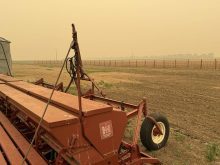Alberta is proposing to restrict fusarium-infected feed and seed grain
shipments from Saskatchewan and Manitoba and corn from the United
States unless the grain can be certified fusarium free.
Shaffeek Ali, chair of an Alberta fusarium task force and head of
Alberta Agriculture’s pest risk management unit, said farmers want to
prevent the spread of fusarium graminearum, a fungus that can be toxic
when fed to livestock. They fear it could devastate the province’s
grain industry if it infects Alberta crops.
Read Also

Saskatchewan puts crown land auction on hold
Auctions of Saskatchewan crown lease land are once again on hold.
“They want the minister to do something to prevent this disease from
taking a foothold in Alberta.”
Ali said Alberta wants to avoid the kind of losses facing Manitoba
farmers, estimated at $50 million to $100 million a year in reduced
yields.
“Our biggest concern is the feed coming into the province from Manitoba
and Saskatchewan and also corn coming in from the U.S. Virtually 99
percent of the feed coming in is contaminated with fusarium at some
level.”
Leo Meyer, a Peace River area grain farmer who is also on the fusarium
task force, said the Alberta government should be commended.
“This is an absolute necessity. We need to prevent this from coming in.
I don’t see any other way of doing things.
“This is the foot-and-mouth disease of the plant.”
Fusarium is already a declared pest in Alberta. Ali said the only
change in policy is to demand that grain coming into the province be
certified fusarium free.
Small amounts of fusarium already exist in Alberta. Ali said that of
1,487 samples of Alberta grain tested between July last year and this
March, 14 tested positive.
A series of meetings are planned for the next few weeks to get input
from cattle feeders, truckers and other interested people. Ali hopes
the proposal will be implemented by the end of May. He said the
legislation is already in place, but his agency would not take action
until provincial agriculture minister Shirley McClellan makes a final
decision.
As well, he said the province would not turn trucks away at the border,
but may work with feedlots to allow some fusarium-infected shipments
with certain restrictions. Details have yet to be worked out.
Dave Guichon with Feedlot Strategies, a Calgary grain brokerage
company, said stopping feed grain imports would devastate southern
Alberta’s feedlots and economy.
“We need to be able to draw grain from other areas,” Guichon said.
It’s estimated that Alberta feedlots imported 100,000 to 150,000 tonnes
of American feed corn a month this past winter between November and
March.
About 80 percent of southern Alberta feedlots used American corn in
their rations this year due to drought-induced barley shortages. A year
earlier, Alberta feedlots bought a large volume of feed grain from
Manitoba and Saskatchewan.
Drought and a steadily growing feeding industry in Alberta have
outstripped provincial growers’ ability to supply the feedlot market.
“In a normal year, with the amount of feeding we’re doing, we would
have a problem sourcing the grain unless it was above average yield in
Alberta,” Guichon said.
A shortage of grain likely would force the price of feed grain to
increase and Alberta’s feedlots would no longer be competitive, he
added.
Ali said the decision to stop fusarium-infected grain from entering
Alberta is important for the industry’s future health.
“In the long run, we’ll be further ahead.”
















